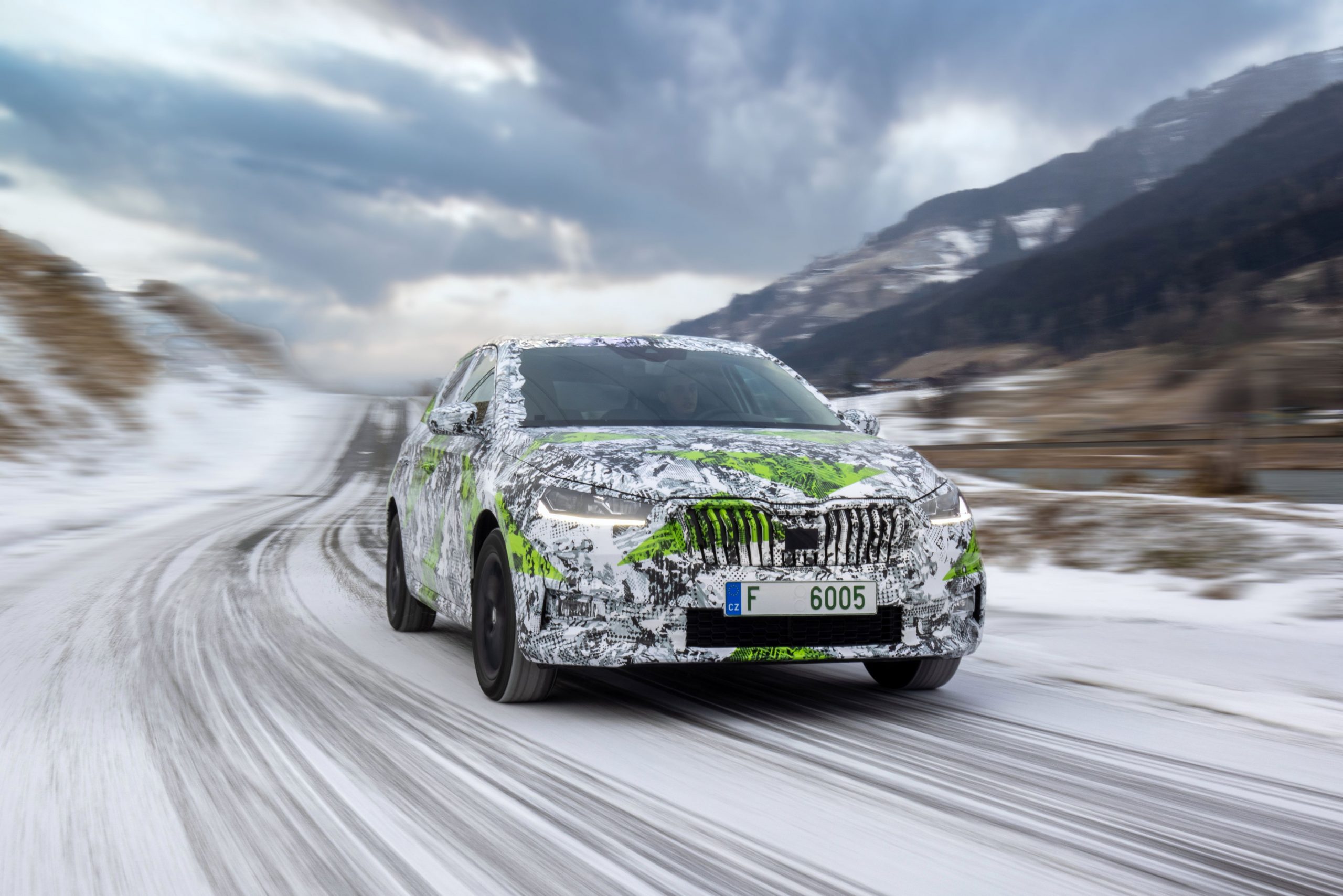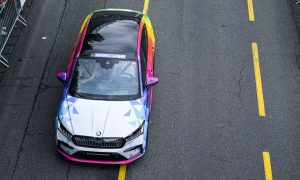
The new ŠKODA Fabia in its fourth generation presents a striking design, bigger interior, increased comfort and, thanks to advanced safety and assistance systems, even greater levels of safety. 22 years after its debut, the popular small car combines classic ŠKODA qualities such as reliability, ease of use and outstanding practicality with enhanced safety, comfort and dynamism.
Johannes Neft, ŠKODA Board Member for Technical Development, emphasised: “Boasting an emotive design language, the new Fabia is a true ŠKODA at first glance. Compared to its predecessor, we have significantly improved the interior – offering a high level of comfort, advanced infotainment and innovative assistance systems. An even more spacious interior, engines that are as efficient as they are powerful, and excellent handling round off the car’s appeal. Our new entry‑level model has everything you could want from a modern small car – and more.”
Small car with cult status
Since its premiere in 1999, the Fabia has been uniting ŠKODA’s brand values. It combines great levels of active and passive safety with a generously sized interior and excellent value for money. It also offers compact exterior dimensions, efficient powertrains and numerous Simply Clever features.
Full LED headlights and tail lights, Virtual Cockpit and new colours
Clear-cut headlights, which extend to the radiator grille, characterise the front view of the new Fabia. Even the standard variant features modern LED technology; full LED headlights with a comprehensive range of functions are available on request. A full LED variant is also available as an option for the tail lights, which feature crystalline structures typical of the brand. The new interior design of the ŠKODA Fabia enhances the small car’s feeling of spaciousness even further. The symmetrical instrument panel with its central, free-standing display, and the horizontal, differently coloured decorative strips (depending on the trim line), emphasise the width of the interior. Furthermore, the Virtual Cockpit is making its Fabia debut.
Oliver Stefani, Head of ŠKODA Design, who has completely reinterpreted ŠKODA’s effective crystalline design language with the successful small car, said: “ŠKODA has consistently continued to develop its design language with the new Fabia. The compact hatchback is particularly sporty and elegant visually. Sculptural lines, dynamic proportions and modern light units with LED technology and the crystalline structures typical of ŠKODA make for a dynamic and modern appearance.”
First ŠKODA Fabia based on the MQB-A0 platform
The influence of the MQB-A0 platform on the vehicle proportions can be seen in the Fabia’s new dimensions. Despite the increase in size, the ŠKODA engineers have succeeded in maintaining the weight close to that of the third-generation model.
Two MPI petrol engines and three TSIs with direct injection
With a portfolio of five efficient petrol engines (from 48 kW to 110 kW) to choose from, and its agile handling, the new ŠKODA Fabia is ideally equipped to cover both short and long distances. Its compact dimensions make it ideal for urban traffic. All five engines are from Volkswagen Group’s new EVO generation and for the most part offer a combined fuel consumption of approximately five litres per 100 km in the WLTP cycle. With the introduction of the new generation, the ŠKODA Fabia is now also available with a new top-of-the-range engine. The 1.5 TSI produces 110 kW (150 PS) from its four cylinders and is combined with a 7-speed DSG as standard.
Lowest drag coefficient within its segment
Compared to its predecessor, the Fabia’s drag coefficient (cd) has dropped from 0.32 to 0.28, making it the most aerodynamically efficient small car in its segment. The aerodynamics have been improved using highly accurate CFD (Computational Fluid Dynamics) simulations. The numerous innovative details developed include actively adjustable cooling shutters in the front bumper’s lower air intake.
Excellent active and passive safety
The car’s occupants are protected by up to nine airbags in the event of an accident. Additional ISOFIX anchors and top tether anchor points are available and also, for the first time, for the front passenger seat. Its comprehensive safety equipment makes the Fabia one of the safest vehicles in its segment.
13 new Simply Clever features
For many years, ŠKODA has been making everyday life that little bit easier for its customers with a constant stream of new and ingenious Simply Clever features. The new Fabia continues this tradition and, in its fourth generation, offers no fewer than 13 new solutions, some of which have found their way into the Fabia for the first time from other ŠKODA models. The new-generation Fabia offers a total of 43 Simply Clever features.
The model’s history: a success story continues
- Three generations and more than 4.5 million units of the ŠKODA Fabia sold since 1999
- The Fabia is an important cornerstone for the Czech brand’s international success
- Germany is the largest sales market, ahead of the Czech Republic and the UK
The fourth-generation ŠKODA Fabia continues an extraordinary success story that began back in 1999. Since its market launch 22 years ago, the Czech carmaker has produced more than 4.5 million units of the popular small car. This makes the Fabia one of the bestselling vehicles in its segment. Germany has been the popular small car’s largest sales market for many years. Thanks to numerous further developments, the latest generation has all the prerequisites to continue this impressive success story.
Since its premiere in 1999, the Fabia has been uniting ŠKODA’s brand values. It combines a generously sized interior with great levels of active and passive safety and excellent value for money. It also offers compact exterior dimensions, efficient powertrains and numerous Simply Clever features. Thanks to these qualities, the Fabia has established itself as a key pillar of the Czech carmaker’s success and is now one of the bestselling models in its segment. The Fabia is the second-most produced ŠKODA model after the Octavia, with more than 4.5 million units since its launch 22 years ago. In 2019 alone, more than 166,000 vehicles rolled off the production line; 37,800 went to customers in Germany, the largest sales market, ahead of the Czech Republic (24,600) and the UK (20,000).
A face of the brand with a loyal customer group since 1999
The first-generation ŠKODA Fabia celebrated its premiere in 1999; the ŠKODA Fabia estate made its debut a year later. With 1.79 million vehicles produced in roughly eight years, the Fabia mark I proved to be a success right from the start. This was followed by the second generation presented at the Geneva Motor Show in 2007, which saw sales of 1,704,000 units in total. The third-generation Fabia has been popular since 2014 and was given a revamp in 2018 with a host of new safety features and advanced infotainment systems. Over one million cars of this generation have been produced to date.
Since the launch of the Fabia, ŠKODA has continuously developed the material concept of the body. In the new generation, the use of high-strength and hot-formed steels contributes to high torsional stiffness. The new Fabia shares chassis components with the ŠKODA Scala, for example, and is one of the first cars in its segment to feature the actively adjustable cooling shutters in the front bumper’s lower air intake, which help to optimise aerodynamics and improve cooling efficiency, from the new Octavia.
Powertrain range: five efficient petrol engines
- Wide range of powertrains from 48 kW (65 PS) to 110 kW (150 PS)
- All engines from Volkswagen Group’s new EVO generation
The new ŠKODA Fabia offers a choice of five efficient petrol engines. With this, ŠKODA has not only increased the number of different engines compared to the predecessor, but the range of power outputs – from 48 kW (65 PS) to 110 kW (150 PS) – is also significantly wider than before. All five engines are from Volkswagen Group’s new EVO generation and for the most part allow for a combined fuel consumption of approximately five litres per 100 km in the WLTP cycle. This makes the new Fabia up to 10 per cent more economical than the model’s predecessor.
The range of engines available for the new ŠKODA Fabia includes two multipoint injection (MPI) petrol engines and three TSIs with direct injection. The new entry-level engine is a 1.0 MPI with three cylinders and an output of 48 kW (65 PS). This is an increase of 4 kW (5 PS) compared to its predecessor. Power is transmitted to the front wheels via a new manual 5-speed gearbox, which is also used in the variant featuring the second MPI engine. This generates an output of 59 kW (80 PS). Both MPI engines in the new ŠKODA Fabia comply with the current Euro 6d emissions standard.
New type of plasma coating on 1.0 TSI engines
The two EVO-generation three-cylinder 1.0 TSI engines feature an innovative plasma coating. The cylinder liners have been powder-coated with a thin layer measuring just 150 μm (0.15 mm). This reduces internal friction, which lowers fuel consumption, emissions and, by better distribution and dissipation of heat in the combustion chamber, the thermal load on the engine. The 1.0 TSI producing 70 kW (95 PS) comes with a manual 5-speed gearbox, while the more powerful 1.0 TSI delivering 81 kW (110 PS) is coupled with a manual 6-speed gearbox. The 1.0 TSI with a power output of 81 kW (110 PS) can also be equipped with a 7‑speed DSG as an option.
New top-of-the-range engine producing 110 kW (150 PS)
With the change to the fourth-generation model, the ŠKODA Fabia is now also available with a new top-of-the-range engine. The 1.5 TSI produces 110 kW (150 PS) from its four cylinders and is combined with a 7-speed DSG as standard. This engine, which is also used in other ŠKODA models, features active cylinder technology (ACT). When engine load is low, this automatically, and virtually without the driver noticing, shuts down two cylinders, thereby reducing fuel consumption. All TSI engines in the new ŠKODA Fabia have petrol particulate filters and comply with the current Euro 6d emissions standard.
Previous article
Hyundai announces New SANTA FE prices and specifications


